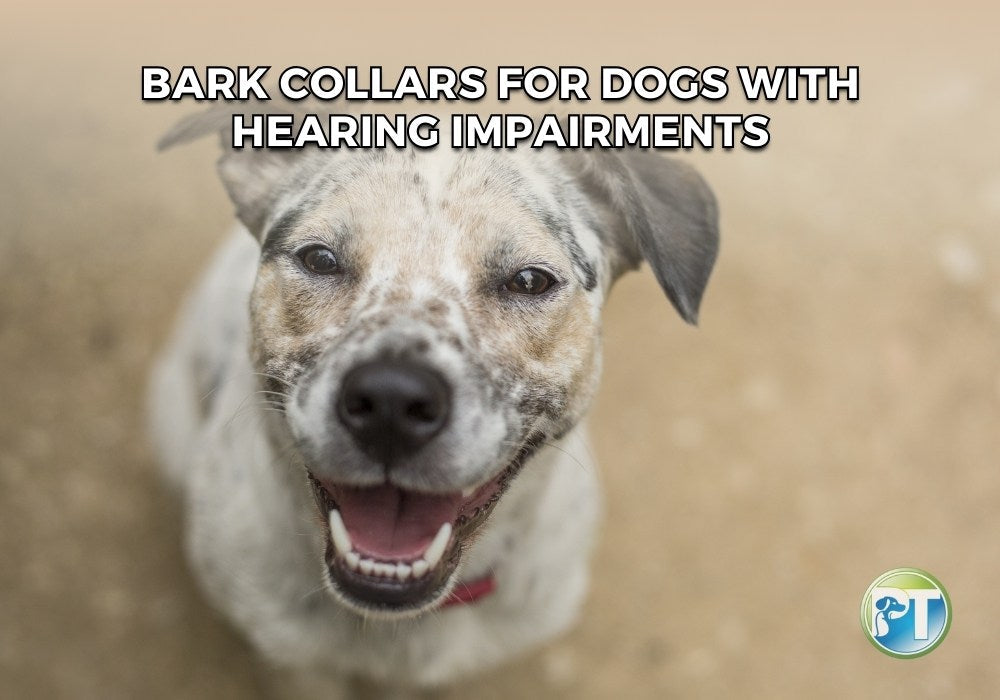Bark Collars for Dogs with Hearing Impairments: Safe Options & Tips

Dogs with hearing impairments face unique challenges, particularly in communication and behavior. Excessive barking is a common issue, often resulting from frustration, anxiety, or confusion about their surroundings.
Bark collars can assist hearing-impaired dogs by offering sensory feedback. These collars improve communication, reduce stress, and enhance safety. In this guide, we’ll explain how bark collars work, what to consider when choosing one, and how to introduce it safely.
Understanding the Needs of Hearing-Impaired Dogs

Dogs with hearing impairments often struggle with traditional training methods that rely on verbal commands. Without the ability to hear cues, they may develop behavioral issues like excessive barking to respond to things they don’t fully understand. To manage this, it’s important to use training tools that rely on signals other than sound.
Non-verbal communication is key when training hearing-impaired dogs. This is where anti bark collars come in. They help signal when to stop barking, even if the dog can’t hear commands. Bark collars give clear, gentle signals that help dogs understand boundaries without causing harm.
How Bark Collars Work for Hearing-Impaired Dogs
When controlling excessive barking, there are four main types of dog bark collars: vibration, spray, static, and ultrasonic. Let’s explore how each type works and see which one is the best fit for dogs with hearing loss.
1. Vibration Bark Collars

Vibration bark collars are an excellent option for hearing-impaired dogs because they deliver a physical response to barking. When the dog barks, the collar vibrates gently, signaling the dog to stop. These collars typically have adjustable vibration levels, allowing owners to customize the intensity to suit their dog’s needs.
For deaf dogs, vibrations are the most effective way to communicate since they can't hear. A well-timed vibration helps the dog connect the sensation with barking, encouraging them to stop.
2. Spray Bark Collars

Spray collars release a harmless burst of unscented or citronella scent when a dog barks. The sudden spray startles the dog and discourages further barking. These collars don't rely on sound, making them effective for both hearing-impaired and deaf dogs.
For dogs sensitive to vibrations, or for owners who prefer to avoid physical corrections, spray collars offer a gentle yet effective alternative. The scent is safe, but dogs typically dislike it, learning to associate barking with the unpleasant odor.
3. Static Bark Collars

Static bark collars give a mild, harmless static correction when a dog barks. The sensation is similar to a light static shock – safe but effective at getting the dog’s attention. These collars usually have adjustable intensity levels, so you can find the right setting for your dog.
The static signal doesn’t rely on sound, making it a good option for dogs that are deaf or partially deaf. It's important to use static collars carefully, starting with the lowest setting to ensure your dog is comfortable and safe.
4. Ultrasonic Bark Collars

Ultrasonic bark collars emit a sound that humans can’t hear but dogs can detect. These collars may work for dogs with partial hearing, but they are ineffective for completely deaf dogs.
If a dog’s hearing loss is significant, even partial, the ultrasonic sound might not work. In such cases, vibration or spray collars are often more suitable alternatives.
Factors to Consider When Choosing a Bark Collar for Hearing-Impaired Dogs
When selecting a no bark collar for your hearing-impaired dog, there are several key factors to keep in mind:
1. Bark Detection Sensitivity
The bark detection technology in a dog bark collar is crucial. It should accurately detect your dog’s barking without being triggered by other sounds or noises. A collar that activates unnecessarily can confuse or frustrate your dog, especially if they have hearing impairments.
2. Collar Fit and Comfort
A bark collar should fit snugly around your dog’s neck, but it should never be too tight. It’s important to choose the right size for your dog, as an ill-fitting collar can cause discomfort or skin irritation. Most bark collars come with adjustable straps, allowing you to customize the fit for your dog.
3. Type of Correction (Static, Spray, Vibration, or Ultrasonic)
As discussed earlier, hearing-impaired dogs will not respond to sound-based corrections. Therefore, it’s essential to choose a collar that uses other correction modes other than sound.
- Static collars: Safe and effective for dogs that need a clear or stronger signal.
- Vibration collars: A good alternative to static correction for dogs that need a softer physical signal.
- Spray collars: Ideal for dogs that may not respond well to physical stimuli but can be deterred by smells.
- Ultrasonic collars: Best for dogs with partial hearing.
Assess your dog’s temperament to decide which type of correction would be most effective.
4. Durability and Battery Life
Invest in a durable bark collar that can withstand regular use, especially if your dog spends a lot of time outdoors. Waterproof collars are a good choice for dogs that enjoy outdoor activities, as they can handle exposure to rain, water, or mud.
Additionally, check the battery life. Some bark collars come with rechargeable batteries, while others may need to be replaced frequently. A long-lasting battery ensures the collar is ready whenever your dog needs it.
Best Bark Collars for Hearing-Impaired Dogs
Below are some great options that can help control barking in hearing-impaired dogs:
1. PetSafe Vibration Bark Collar (PBC00-12789)
Best for Dog Size: For Dogs of Any Size
Collar Receiver Size: 2.24” x 1.06” x 1.1”
Collar Receiver Weight: 2.61 oz
The PetSafe Vibration Bark Collar is a solid choice for dogs with hearing loss because it uses vibration-only correction to control barking. It features 10 customizable vibration settings, so you can adjust the intensity to match your dog’s needs. Its Perfect Bark® Sound & Vibration Sensors ensure that barking is detected accurately, minimizing the chances of false corrections.
2. Dogtra iQ Vibe No Bark Collar
Best for Dog Size: 10 Pounds and Up
Collar Receiver Size: 1.49" x 2.20" x 1.42"
Collar Receiver Weight: 1.5 oz
The Dogtra iQ Vibe is specifically designed for small to medium-sized dogs, making it ideal for hearing-impaired dogs weighing 10 pounds or more. It uses vibration-only feedback, with three adjustable intensity levels to customize the correction. The vibrations are about four times stronger than a typical cellphone, ensuring the dog can easily feel the signal.
3. PetSafe Elite Little Dog Spray Bark Collar (PBC00-11283)
Best for Dog Size: 8 Pounds and Up
Collar Receiver Size: 1.7” x 1.06” x 0.98”
Collar Receiver Weight: 2.26 oz
Designed for smaller dogs, the PetSafe Elite Little Dog Spray Bark Collar uses citronella spray to control barking. Its Perfect Bark® Technology ensures the collar activates only when your dog barks, preventing false triggers. The lightweight design and gentle spray make it suitable for hearing-impaired dogs that are more sensitive to physical corrections.
4. PetSafe PBC00-16368 Spray Bark Collar
Best for Dog Size: 8 Pounds and Up
Collar Receiver Size: 2.44” x 1.37” x 1.22”
Collar Receiver Weight: 3.63 oz
The PetSafe PBC00-16368 uses a spray correction method activated by your dog's barking. With citronella and unscented spray cartridges, you can choose the option that best suits your dog’s sensitivity. The collar is rechargeable and has a recyclable refill system for easy maintenance. This is another great option for dogs that do not respond to physical corrections but need a non-auditory cue to reduce barking.
5. Dogwatch BT-7 No-Bark Trainer

Best for Dog Size: 4 Pounds and Up
Collar Receiver Size: 2.67” x 1.18” x 1.57”
Collar Receiver Weight: 1.7 oz
The Dogwatch BT-7 offers both static correction and vibration, giving you the flexibility to choose the most effective method for your dog. With 7 adjustable static levels and a vibration option, you can tailor the correction to suit your dog’s temperament. The Bark Forgiveness feature adds a short delay before stimulation, helping your dog understand when barking is excessive.
How to Safely Introduce a Bark Collar to Your Hearing-Impaired Dog
Introducing a bark collar requires patience and care to ensure your dog feels comfortable and understands the collar’s purpose.

Step 1: Familiarize Your Dog with the Collar
Before using the dog bark collar, allow your dog to sniff and investigate it. Let them wear it for short periods without activating the correction, so they can get used to the feel of the collar.
Step 2: Use Positive Reinforcement
While using the anti bark collar, continue to reinforce positive behavior with treats or praise. When your dog responds to the collar by stopping barking, reward them immediately. This helps them associate the correction with good behavior.
Step 3: Monitor Their Reactions
Especially in the first few days of using the collar, observe how your dog reacts to the correction. If the collar seems to cause undue stress or anxiety, reconsider the sensitivity setting. Alternatively, consult a professional trainer to ensure the collar is the right choice for your dog.
Step 4: Limit Usage
Don’t keep the bark collar on your dog for extended periods. Use it during training sessions or times when excessive barking is likely. This ensures the dog doesn’t become overly dependent on the collar for behavioral control.
Final Thoughts
When choosing a bark collar for your hearing-impaired dog, it’s important to consider their specific needs, temperament, and sensitivity. Vibration-based collars are often the best choice for deaf dogs, while citronella collars provide a non-physical alternative. No matter which option you choose, always prioritize your dog’s comfort and well-being.
You might also enjoy...
-
Posted in
E-Collar Info & Guides






